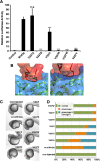Molecular dissection of Wnt3a-Frizzled8 interaction reveals essential and modulatory determinants of Wnt signaling activity
- PMID: 24885675
- PMCID: PMC4068752
- DOI: 10.1186/1741-7007-12-44
Molecular dissection of Wnt3a-Frizzled8 interaction reveals essential and modulatory determinants of Wnt signaling activity
Abstract
Background: Wnt proteins are a family of secreted signaling molecules that regulate key developmental processes in metazoans. The molecular basis of Wnt binding to Frizzled and LRP5/6 co-receptors has long been unknown due to the lack of structural data on Wnt ligands. Only recently, the crystal structure of the Wnt8-Frizzled8-cysteine-rich-domain (CRD) complex was solved, but the significance of interaction sites that influence Wnt signaling has not been assessed.
Results: Here, we present an extensive structure-function analysis of mouse Wnt3a in vitro and in vivo. We provide evidence for the essential role of serine 209, glycine 210 (site 1) and tryptophan 333 (site 2) in Fz binding. Importantly, we discovered that valine 337 in the site 2 binding loop is critical for signaling without contributing to binding. Mutations in the presumptive second CRD binding site (site 3) partly abolished Wnt binding. Intriguingly, most site 3 mutations increased Wnt signaling, probably by inhibiting Wnt-CRD oligomerization. In accordance, increasing amounts of soluble Frizzled8-CRD protein modulated Wnt3a signaling in a biphasic manner.
Conclusions: We propose a concentration-dependent switch in Wnt-CRD complex formation from an inactive aggregation state to an activated high mobility state as a possible modulatory mechanism in Wnt signaling gradients.
Figures








References
-
- Holstein TW, Watanabe H, Ozbek S. Signaling pathways and axis formation in the lower metazoa. Curr Top Dev Biol. 2011;12:137–177. - PubMed
Publication types
MeSH terms
Substances
Grants and funding
LinkOut - more resources
Full Text Sources
Other Literature Sources
Molecular Biology Databases

